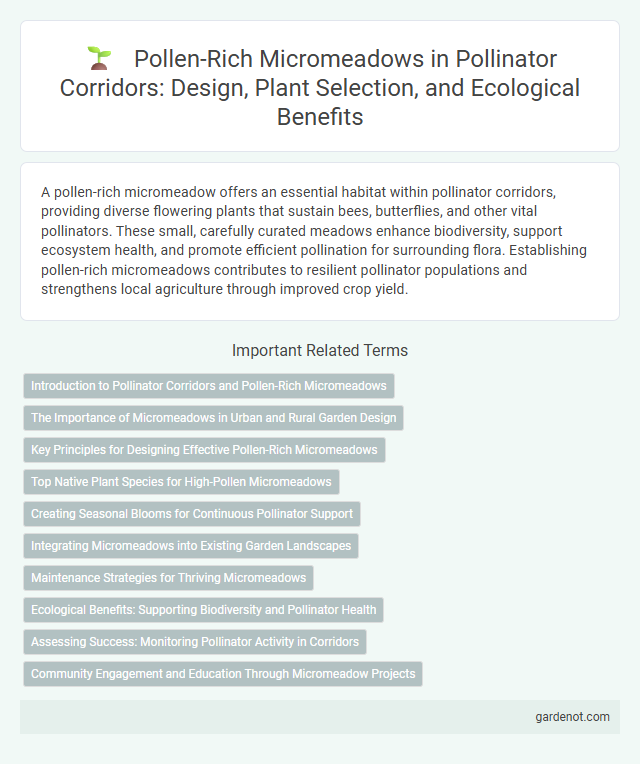A pollen-rich micromeadow offers an essential habitat within pollinator corridors, providing diverse flowering plants that sustain bees, butterflies, and other vital pollinators. These small, carefully curated meadows enhance biodiversity, support ecosystem health, and promote efficient pollination for surrounding flora. Establishing pollen-rich micromeadows contributes to resilient pollinator populations and strengthens local agriculture through improved crop yield.
Introduction to Pollinator Corridors and Pollen-Rich Micromeadows
Pollinator corridors are strategic strips of habitat designed to connect fragmented ecosystems, supporting the movement and survival of vital pollinators such as bees, butterflies, and hummingbirds. Pollen-rich micromeadows play a critical role within these corridors by providing concentrated resources of diverse nectar and pollen sources, enhancing pollinator nutrition and biodiversity. The establishment of these micromeadows within urban and rural landscapes increases ecological connectivity and boosts the health of pollination networks essential for food production and native plant reproduction.
The Importance of Micromeadows in Urban and Rural Garden Design
Pollen-rich micromeadows enhance biodiversity by supporting diverse pollinator populations essential for both urban and rural ecosystems. Integrating these micromeadows in garden designs improves pollination rates, promotes native plant growth, and sustains local food webs. Their compact size enables effective habitat creation in limited spaces, optimizing ecological benefits and contributing to resilient green infrastructure.
Key Principles for Designing Effective Pollen-Rich Micromeadows
Designing effective pollen-rich micromeadows hinges on selecting diverse native flowering plants that bloom sequentially from early spring to late fall to ensure continuous pollen availability. Incorporating a variety of flower morphologies supports a broad spectrum of pollinators, enhancing ecosystem resilience and pollination services. Strategic site preparation, minimal disturbance, and avoiding pesticide use optimize habitat quality and promote sustained pollinator activity in micromeadows.
Top Native Plant Species for High-Pollen Micromeadows
Top native plant species for high-pollen micromeadows include Solidago spp. (goldenrod), Monarda fistulosa (wild bergamot), and Echinacea purpurea (purple coneflower). These species produce abundant pollen and attract diverse pollinators such as bees, butterflies, and hoverflies, enhancing pollinator corridor effectiveness. Incorporating a mix of these plants ensures continuous bloom periods and maximizes pollen resources for supporting local pollinator populations.
Creating Seasonal Blooms for Continuous Pollinator Support
Pollen-rich micromeadows are designed to provide continuous seasonal blooms that sustain diverse pollinator populations throughout the year. By incorporating a variety of native, flowering plants that bloom sequentially from spring to fall, these micromeadows ensure a steady supply of nectar and pollen. This strategy enhances pollinator health and biodiversity by supporting native bees, butterflies, and other essential pollinating insects in pollinator corridors.
Integrating Micromeadows into Existing Garden Landscapes
Integrating pollen-rich micromeadows into existing garden landscapes enhances biodiversity by providing essential forage for pollinators such as bees, butterflies, and hoverflies. These compact, low-maintenance habitats improve soil health, support native flora, and create continuous pollen sources throughout the growing season. Strategic placement within urban or rural gardens fosters ecological connectivity, promoting pollinator corridor effectiveness and landscape resilience.
Maintenance Strategies for Thriving Micromeadows
Pollen-rich micromeadows require targeted maintenance strategies to sustain their biodiversity and pollinator support. Regular mowing schedules that avoid peak flowering times prevent disruption to nectar sources while promoting plant diversity. Incorporating seasonal assessments and adaptive management ensures the micromeadow remains a vibrant corridor for pollinators throughout the year.
Ecological Benefits: Supporting Biodiversity and Pollinator Health
Pollen-rich micromeadows provide essential habitats that support diverse pollinator species, including bees, butterflies, and hoverflies, by supplying abundant nectar and pollen resources throughout the growing season. These microhabitats enhance local biodiversity by fostering the reproduction of native wildflowers and contributing to ecological resilience against habitat fragmentation. Maintaining pollen-rich micromeadows within pollinator corridors improves pollinator health and ecosystem services such as crop pollination and natural pest control.
Assessing Success: Monitoring Pollinator Activity in Corridors
Monitoring pollinator activity in pollen-rich micromeadows involves systematic surveys of bee species diversity and abundance, coupled with floral resource assessments to evaluate habitat quality within corridors. Utilizing methods such as pan trapping, netting, and timed observations provides quantitative data on pollinator visitation rates and foraging behavior. Long-term monitoring enables detection of population trends and effectiveness of micromeadows in enhancing pollinator connectivity and ecosystem services.
Community Engagement and Education Through Micromeadow Projects
Pollen-rich micromeadows serve as vital habitats for diverse pollinators while fostering community engagement through hands-on educational programs. Local workshops and citizen science initiatives encourage residents to participate in planting and monitoring, enhancing awareness of pollinator conservation. These projects create accessible green spaces that double as living classrooms, promoting environmental stewardship and biodiversity literacy.
Pollen-rich micromeadow Infographic

 gardenot.com
gardenot.com